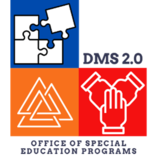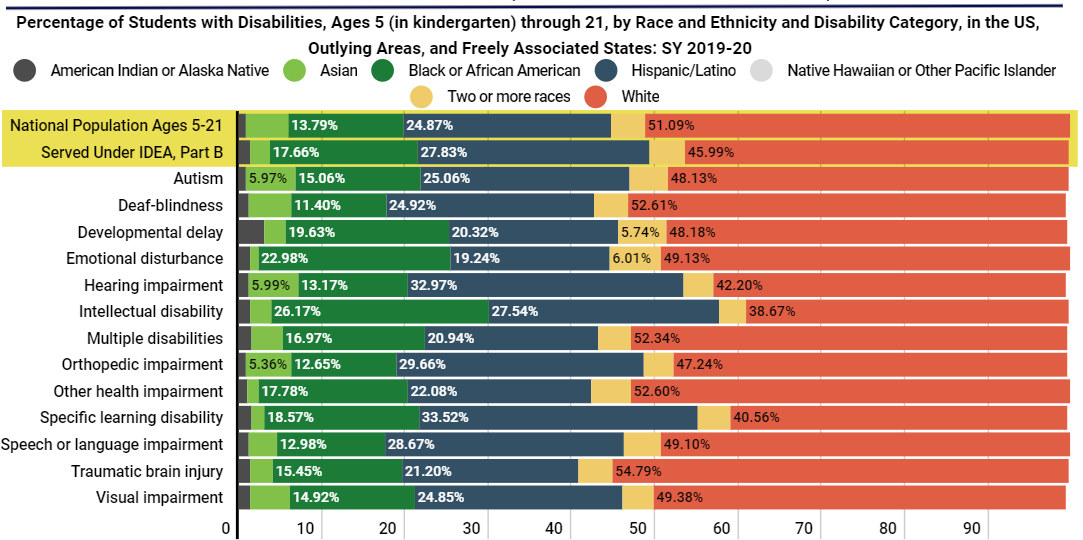In This Issue:
From the Director

Message from Acting OSEP Director, Dr. David Cantrell
Dear Stakeholders!
Happy Holidays. With Thanksgiving behind us, Advent and Hannukah well underway and Christmas and Kwanzaa a few weeks away, I hope that you and your loved ones have a wonderful holiday season. Personally, I try to find some time during December to reflect on the importance of our work and the amazing job early interventionists and special educators do every day across the country.
As educators and practitioners with a focus on children with disabilities we do “good work.” Adapting the phrase from the bible, doing good work means providing services to an infant who may never remember the impacts the services had in her life. Good work is also the extra time spent after school modifying lessons so children with disabilities will be able to meaningfully participate and learn in class with their peers. And good work is being able to turn the other cheek and implement a behavior intervention plan for a child who knows how to push everyone’s buttons.
This holiday season, I’m going to ask that you do some additional good work for a new set of children and their families. Through Operation Allies Welcome, the United States Departments of Defense and Homeland Security will be transferring thousands of Afghan refugees from military installations to communities across the country. Many of the families may be English learners and may have experienced trauma while living in or fleeing from Afghanistan. I encourage you to check in with the Operation Allies Welcome website for updated information. Some of these children may also require early intervention or special education services under IDEA.
Thank you for all that you do to support infants, toddlers, children and youth with disabilities! I wish you an enjoyable holiday season and look forward to seeing you next year!
David Cantrell, Ph.D.
Acting Director
Office of Special Education Programs
|
ED Update

Rural America at a Glance, 2021 Edition
On Wednesday, December 8th, 2021 from 12:00pm to 1:00pm PST, Regional Educational Laboratories West will host a webinar based on key findings from the recent REL West report, Academic Mindsets and Behaviors, Prior Achievement, and the Transition to Middle School. The webinar will provide an overview of the relevant literature establishing the relationship between grade 5 academic mindsets and behaviors and the risk of having a low GPA during the transition to middle school and explain and answer questions about the study findings on this relationship in the study’s subject, Clark County School District. To register, click here.
|
Policy Letters
Letter to Anonymous on Due Process Hearing
The Letter to Anonymous (November 17, 2021), addresses whether an local educational agency (LEA) may request a due process hearing to override the parent’s refusal to consent to a change in the child’s individualized education program (IEP) or educational placement. The letter also discusses whether a parent has met IDEA’s exhaustion requirements if a hearing officer determines that the SEA is not a proper party to a due process hearing.
Letter to Boals Regarding IEPs if the Child is an English Learner
The Letter to Boals (November 15, 2021) addresses whether IDEA requires the public agency to include language development goals in a child’s IEP if the child is an English learner. In this letter, OSEP identifies best practices that districts, schools, and teachers can use to ensure they provide appropriate instruction to English learners with disabilities. The letter also includes a list of resources for further information on development of IEPs and provision of appropriate instruction for English learners with disabilities.
Announcements
Technical Assistance (TA) Calls
Next TA Calls:
December 9, 2021 at 4:00–5:00pm (EST)
During the first December National TA Call, OSEP will provide an overview of the recently released Part C Return to School Roadmap documents: Child Find, Referral, and Eligibility; and Provision of Early Intervention Services. This Q&A document offer guidance to state related to the implementation of Child Find and early intervention services, including IDEA Part C to Part B transition, as programs continue to increase in-person services.
December 16, 2021 at 4:00–5:00pm (EST)
There will be a second December National TA call on Differentiated Monitoring and Support 2.0 (DMS 2.0) activities. As part of the Universal TA, the DMS National TA calls will provide guidance on specific puzzle pieces in coordination with our Phase I monitoring activities, or other guidance related to DMS 2.0.
Previous TA Call:
November 18, 2021 at 4:00–5:00pm (EST) — DMS
(All National TA calls are recorded and typically posted within a week)
State Performance Plans / Annual Performance Reports (APRs)
Please mark your calendar for two upcoming webinars regarding the APR Reporting Tool, EDFacts Metadata and Process System (EMAPS):
- Tuesday, December 14, 2021 at 2:00–3:30pm (EST) — Part C
- Wednesday, December 15, 2021 at 2:00–3:30pm (EST) — Part B
EMAPS will open on December 20, 2021 for this year’s submission process.
Updated information regarding the next SPP/APR submission due on February 1, 2022 was presented on the October 14, 2021 OSEP National Monthly Technical Assistance call. Information on the new SPP/APR submission package are posted on our IDEA Website.
 |
IDEA Part B/C Grants
Reviews are being conducted of states’ Part C Section III/American Rescue Plan (ARP) documents in collaboration with the Fiscal Implementation Team. These documents specify how Part C programs are planning to use their ARP funds. Information and follow-up activities from these analyses will be provided soon.
OSEP will present on the 2022 Grant Application process during the January 13, 2022 OSEP National TA Call. Please stay tuned for registration details.
 |

Differentiated Monitoring and Support (DMS)
New DMS resources have been posted on the DMS section of our IDEA website!
OSEP’s next Technical Assistance (TA) Call on DMS is scheduled for December 16, 2021, and will review the protocols on Integrated Monitoring and Sustaining Compliance and Improvement. Please note that the next DMS TA Call will be on the third Thursday, due to the Federal Holiday occurring near the fourth Thursday. Please check the OSEP Monthly TA Call page for additional information to register, review previously recorded calls, and access the schedule.
All States are encouraged to review and use the currently posted protocols, these protocols are tools for States to use now, prior to their active engagement with MSIP for formal monitoring. In addition, the protocols each provide a list of “suggested documents for review,” and includes documents and resources OSEP will need from states to complete their monitoring. To access resources related to monitoring activities (e.g., DMS 2.0, DMS reports, and older monitoring reports, etc.), please refer to the DMS section on our IDEA website.
|
Dose of Data
What Does the Data Tell Us?

Percentage of Students with Disabilities, Ages 5 (in kindergarten) through 21, by Race and Ethnicity and Disability Category: SY 2019–20
The stacked bar chart demonstrates the number and percentage of students with disabilities, ages 5 (in kindergarten) through 21, by Race and Ethnicity and Disability Category. The first row provides the percentage of the national population, ages 5–21 and the second row provides the number and percent of all students with disabilities by race and ethnicity. The other rows display the number and percent of students by disability category and by race and ethnicity.
Consider:
- Look at the first two rows highlighted in yellow. These rows show the national population of ages 5–21 by race ethnicity and the percent of students by race and ethnicity served under IDEA, Part B.
- Look at the rest of the rows which demonstrate the percent of students with disabilities by race and ethnicity and disability category.
- Look at the rows for each disability category as compared to the first two rows.
- What surprises you about this figure?
For more information on racial/ ethnic breakdowns by disability category, please see the OSEP Fast Facts: Race and Ethnicity of Children with Disabilities Served under IDEA Part B.
For additional thought provoking data questions and conversation starters, please see the accompanying Hand in Hand supplemental tool.
Recommended Resources
Breaking Down Barriers to a Meaningful Adult Life
Read the remarkable story of Jason Corning, a young man who’s become a successful college graduate, teacher, business owner, and passionate advocate for the deaf-blind community. Hear his advice about overcoming the challenges of being deaf-blind at school, in the workplace, and in adult life.


Integrating Improvement and Implementation Sciences to Enhance Educational Outcomes
Use this new brief from the State Implementation and Scaling Up of Evidence-based Practices TA Center (SISEP), to learn about similarities and differences between implementation science and improvement science. Get answers to the question “How can implementation and improvement science be used together to support programs and practices that improve outcomes for children with disabilities?” Use the flow chart included to assist your teams in integrating improvement efforts into Active Implementation.
|
 |

NCES releases latest NAEP Long-Term Trend Report for Ages 9 and 13
A new report from the National Center for Education Statistics (NCES) provides information about revenues and expenditures in the nation’s public school districts for school year 2018–19. The report uses provisional data from the School District Finance Survey (F-33), which state education agencies in all 50 states and the District of Columbia submit each year.
|
 |

AEM Center Launches New Podcast, The Accessible Learning Experience
The National Center on Accessible Educational Materials for Learning (AEM Center) has launched a new podcast, The Accessible Learning Experience. Each half-hour episode features interviews with national, state, and local leaders who share their top tips and strategies for implementing accessibility best practices in order to turn learning barriers into learning opportunities.
Season one starts with a three-part interview with CAST co-founders
About the Author
David J. Cantrell, Ph.D., a member of the U.S. Government Senior Executive Service, serves as the acting director in the Office of Special Education Programs (OSEP) within the Office of Special Education and Rehabilitative Services, at the U.S. Department of Education (Department). In this role, he is responsible for overseeing administration of the Individuals with Disabilities Education Act (IDEA), which authorizes formula grants to States under IDEA Part B and to lead agencies for the infants and families program under IDEA Part C. IDEA also authorizes discretionary grants under IDEA Part D to institutions of higher education and other non-profit organizations to support grants for state personnel development, technical assistance and dissemination, technology, and parent training and information centers.
Read next
Policy
Letter from Principal Deputy Assistant Secretary Schott re: ARP Administrative Funds Waivers
USED & White House
U.S. Department of Education Releases Final Title IX Regulations, Providing Vital Protections Against Sex Discrimination
USED & White House
OMB Announces New Final UGG
| |




















